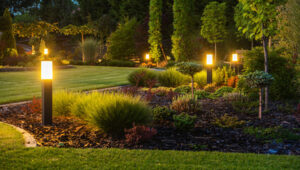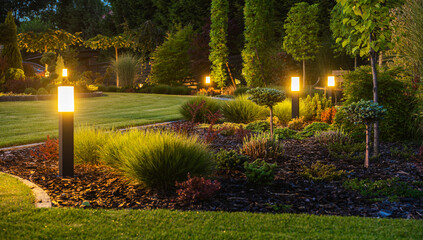Landscape Lighting Orlando, FL can highlight your beautiful home and yard features and add a dramatic effect. It also adds safety elements and increases your property value.
Except for path lighting, your goal with landscape lights is only to see the effects, not the light source itself. To do this, choose fixtures with a high-lumen output.
One of the simplest landscape lighting techniques, path lights help guide the way along walkways and stairs. They are also ideal for highlighting low-growing foliage in landscape beds. Pathway lights come in a variety of styles, including fixtures with classic designs that are popular in contemporary and traditional landscapes, as well as LED options that are energy-efficient and long-lasting. For the best results, use an evenly distributed number of fixtures that provide adequate coverage without oversaturating the space.
While path lighting may seem like a straightforward project, it’s easy to get it wrong. Overuse of this type of fixture can lead to an over-lit walkway that’s uninviting and even dangerous to walk through at night. To avoid this, start with a sketch of the yard at night and determine how many fixtures you really need to illuminate your path. Remember, less is more – illuminating everything in the yard will wash it out and make your space look cramped.
Once you’ve established the number of pathway lights needed, consider their placement and wattage. Too much light will create an ugly glare and can cause people to stumble over each other or trip on obstacles that aren’t visible in the dark. In general, it’s best to use a lower wattage bulb as this will save energy and prevent the bulbs from overheating and burning out prematurely.
Another option for illuminating your walkways is to use hardscape lights. This is a newer technique that uses LED fixtures attached to or built into structures such as walls, posts and decks. This style of lighting is great for highlighting features such as fountains, water features and trees.
Accent lighting is another common landscape lighting technique that highlights specific objects in the garden or on a property. These can include statues, flag poles and centerpiece trees. Properly positioned, this kind of lighting can draw a strong emotional response from your guests. It can also serve to highlight architectural features and other decorative elements in your yard at night. This is done by using a narrow beam to highlight a particular feature that would otherwise be lost in the darkness.
Uplighting
Uplighting is one of the more basic landscape lighting techniques. It involves mounting a light below something you want to highlight, at ground level, and shining it upward. This creates dramatic shadowing effects and makes tall structures or trees look impressive. You can also use this technique to highlight a fountain or statue, giving your favorite features new life at night.
When choosing uplights for your landscaping project, consider their color temperature. Warmer lights (between 3000-4000K) work well on oak trees and brown siding, while cooler whites (4000-5000K) are better suited to modern architecture and stone facades.
Another important consideration when choosing uplights is the wattage needed to illuminate your project. While it may seem counterintuitive to have less lighting, a higher wattage can actually be more efficient when used properly.
The wattage you choose for your uplighting project will also depend on the size of the area you are lighting and the amount of light required to showcase your chosen feature or objects. For example, if you are looking to highlight a small garden area with gentle to moderate light, fixtures ranging from 40-80 watts should be sufficient.
In addition to the aesthetic benefits of uplighting, it’s important to remember that proper landscape lighting can also help with safety and security. When properly installed, a landscape lighting system can add visibility to dangerous areas of your property, including stairs and pathways. This will ensure that you and your guests can safely navigate these spaces at night.
If you’re looking to make the most out of your landscape lighting this winter, be sure to take the time to perform routine maintenance, including replacing bulbs, wiping off dust, and conducting regular wire inspections. This will keep your landscape lights functioning at their best while providing you with years of enjoyment and security.
Mood Lighting
Mood lighting in landscape design is all about creating drama and beauty on your property after dark. This is often the most overlooked element of a landscape lighting plan but it can add a lot of character and depth to your outdoor spaces. The way that mood lighting can be achieved is by using various types of lighting techniques such as silhouetting and backlighting. This type of lighting is especially effective when you have a taller structure such as a tree or sculpture and can highlight it from different angles to create an amazing effect.
Another great option for achieving the right mood is using lighting to illuminate seating areas or pathways. This not only makes the area safer for people to move around in but it also enhances the visual appeal of your home. For example, if you have a stone staircase leading to your front door, lighting it can make the stairs appear more inviting and beautiful.
Lighting can also be used to highlight certain elements of your landscape such as a water feature or a plant that is particularly striking. This is called accent lighting and it can be done in a number of ways including highlighting an architectural feature on the side of your house or simply placing a light at the base of a tree to illuminate its form.
In addition, the color of the light you choose can have a significant impact on the look and feel of your outdoor space. There are many colors available and the right choice can help to set a particular mood for your landscape.
Ultimately, the goal of any landscape lighting system is to balance safety, efficiency and beauty. This means ensuring that all of the tripping hazards are addressed and that your lighting is strong enough to illuminate the edges of any pathways you have, but not so bright that it creates an uninviting glare.
There are a variety of options to choose from when it comes to landscape lighting, including pathway lights, postmount lights and submersible lights for water features. Choosing the correct type of lighting for your needs is important and should be discussed with a professional. They will be able to guide you through the process of choosing the best type of lighting for your yard and the different ways that it can be used to bring a whole new level of functionality, safety and beauty to your outdoor living spaces.
Safety
Safety is one of the most important reasons to use landscape lighting. Illumination reveals potential tripping hazards and helps you keep track of your children or pets as they play in the yard after dark. Lights can also help deter intruders from trespassing on your property, especially with motion sensors.
When the weather turns cold and snowy, proper lighting can enable you to safely navigate your yard and walkways. A well-lit walkway reveals any bumps or cracks in the sidewalk, and keeps you from tripping on ice or slipping in the rain.
Illuminating stairs and other features of your home can also help you stay safe and prevent injury to family members or guests. Adding lights to your entrance can illuminate the steps to your door, making it easier to open the door for guests or to get inside after dark. Lights can also be used to highlight a flagpole, centerpiece tree or other architectural feature of your home to add style and visual appeal at night.
For businesses, illuminating doors and walkways is essential for keeping employees and visitors safe. It makes it easy to find the way back to their cars, and deters criminals from trespassing on the premises after dark. Lighting up utility areas, like dumpsters, can also help prevent injury to people who are working on the site after hours.
Choosing the right lighting for your needs, property and budget is crucial. A professional lighting designer can help you make the best choices for your landscape. They can show you how different types of lighting can improve the beauty and value of your property while adding a layer of security that will deter criminals. For the most effective results, choose lighting fixtures that are designed for outdoor use and have a seal that can handle moisture. This will protect the wires from water and snow that can cause electrical issues. If you have buried wires in your yard, be sure to check them regularly for exposed or damaged wires. Also, be sure to bury any new wires in the spring and fall to protect them from freezing conditions.

